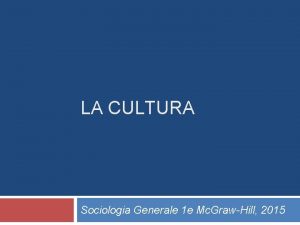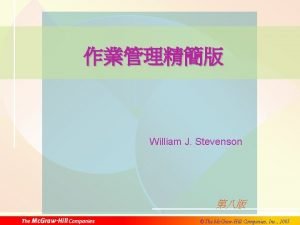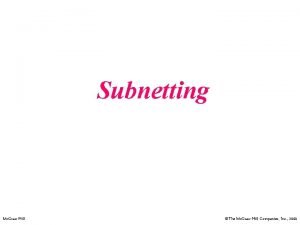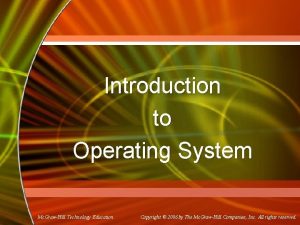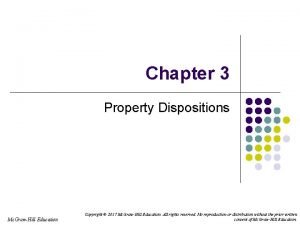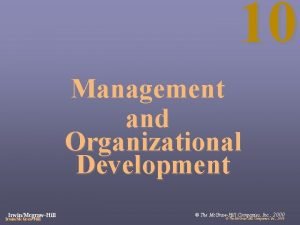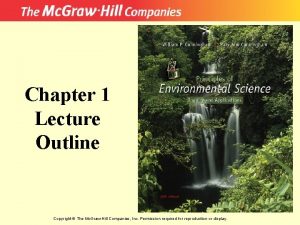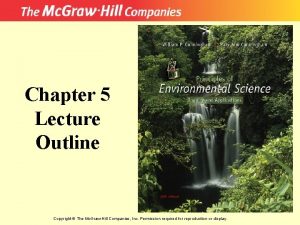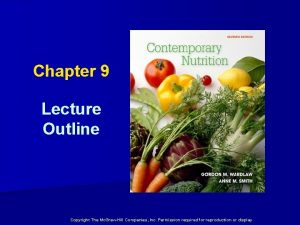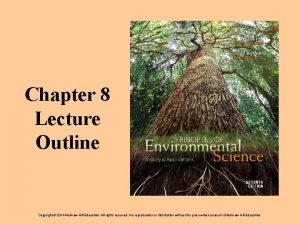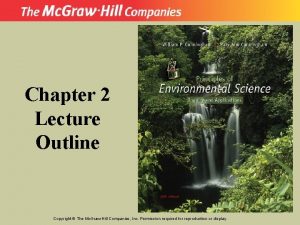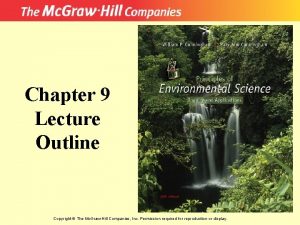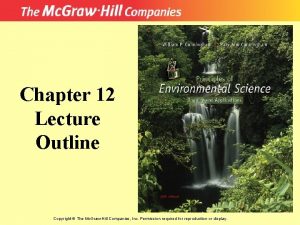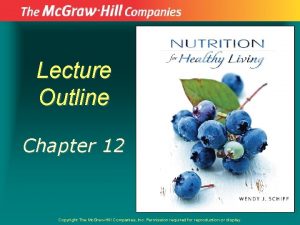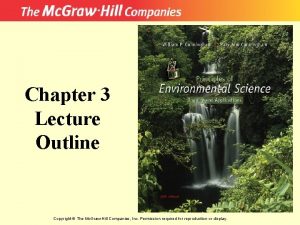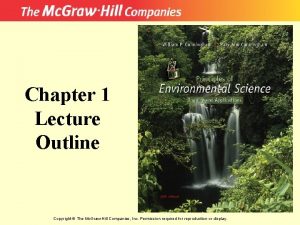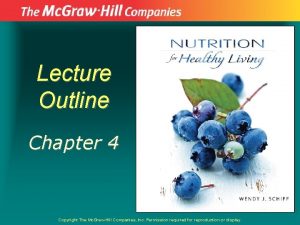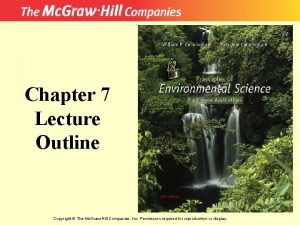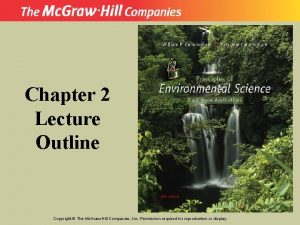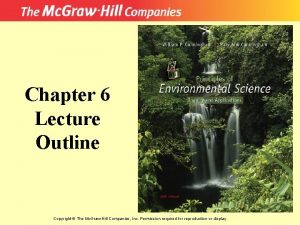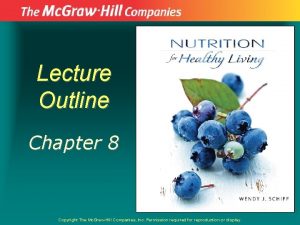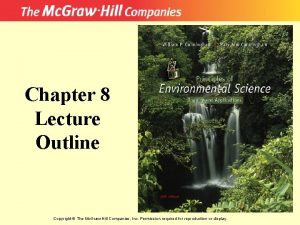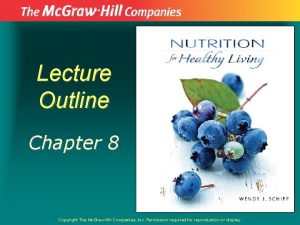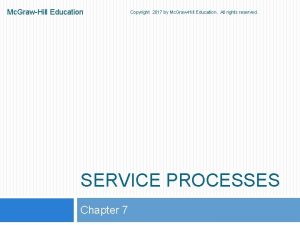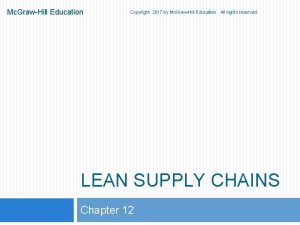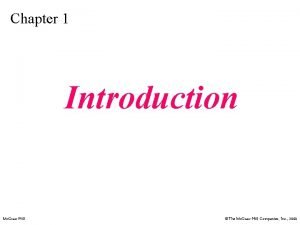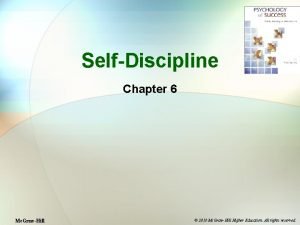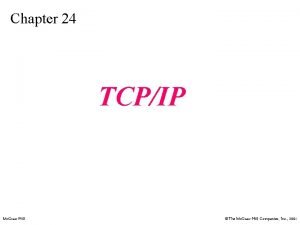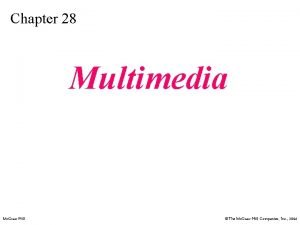Chapter 10 Lecture Outline Copyright The Mc GrawHill









































- Slides: 41

Chapter 10 Lecture Outline Copyright © The Mc. Graw-Hill Companies, Inc. Permission required for reproduction or display.

Learning Outcomes After studying this chapter, you should be able to answer the following questions: • Where does our water come from? How do we use it? • Where and why do water shortages occur? • How can we increase water supplies? What are some costs of these methods? • How can you conserve water? • What is water pollution? What are its sources and effects? • Why are sewage treatment and clean water important in developing countries? • How can we control water pollution? 10 -2

I tell you gentlemen; you are piling up a heritage of conflict and litigation of water rights, for there is not sufficient water to supply the land. –John Wesley Powell 10 -3

10. 1 Water Resources • Water is essential for life. • Water dissolves nutrients and distributes them to cells, regulates body temperature, supports structures, and removes waste products. About 60 percent of your body is water. • You could survive for weeks without food, but only a few days without water. • Water also is needed for agriculture, industry, transportation, and a host of other human uses. In short, clean freshwater is one of our most vital natural resources. 10 -4

10 -5

10. 2 Major Water Compartments • Nearly all the world’s water is in the oceans. • Only about. 02 percent of the world’s water is in a form accessible to us and to other organisms that rely on fresh water. 10 -6

Groundwater stores most fresh, liquid water • Zone of aeration – Shallow layer of soil containing both air and water. • Zone of saturation – Lower soil layer with pores filled with water. • Water table – Top of zone of saturation that supplies most wells. 10 -7

Aquifers 10 -8

10. 3 Water Availability and Use • We now appropriate more than half of all the freshwater in the world. • Perhaps more than any other environmental factor, the availability of water determines the location and activities of human beings on the earth. • Renewable water supplies are resources that are replenished regularly—mainly surface water and shallow groundwater. • Renewable water is most plentiful in the tropics, where rainfall is heavy, followed by mid-latitudes, where rainfall is regular. 10 -9

Droughts • Droughts are often cyclic, and land-use practices exacerbate their effects. • In the United States, the cycle of drought seems to be about 30 years. • There were severe dry years in the 1870 s, 1900 s, 1930 s, 1950 s, and 1970 s. 10 -10

Agriculture is our greatest water user • Agriculture claims about 70 percent of total water withdrawal. 10 -11

10. 4 Freshwater Shortages • Clean drinking water and basic sanitation are necessary to prevent communicable diseases and to maintain a healthy life. • For many of the world’s poorest people, one of the greatest environmental threats to health remains the continued use of polluted water. • In Mali 88 percent of the population lacks clean water; in Ethiopia, it is 94 percent. 10 -12

Many people lack access to clean water • More than two-thirds of the world’s households have to fetch water from outside the home. • This is heavy work, done mainly by women and children and sometimes taking several hours a day. • Improved public systems bring many benefits to these poor families. 10 -13

Groundwater supplies are being depleted • Groundwater provides nearly 40 percent of the fresh water for agricultural and domestic use in the United States. • In many areas of the United States, groundwater is being withdrawn from aquifers faster than natural recharge can replace it. 10 -14

Diversion projects redistribute water • Dams and canals are a foundation of civilization because they store and redistribute water for farms and cities. • More than half of the world’s 227 largest rivers have been dammed or diverted. • Economically speaking, at least one-third of the world’s large dams should never have been built. 10 -15

10 -16

Questions of justice often surround dam projects • While dams provide hydroelectric power and water to distant cities, local residents often suffer economic and cultural losses. • Canada’s James Bay project, built to sell electricity to New York markets, flooded more than 10, 000 km 2 (4, 000 m 2) of forest and tundra. • In 1984, 10, 000 caribou drowned while trying to follow ancient migration routes across newly flooded land. 10 -17

Would you fight for water? • Fortune magazine wrote “water will be to the 21 st century what oil was to the 20 th. ” • Already we’ve seen skirmishes—if not outright warfare—over insufficient water. • In Kenya, for instance, nomadic tribes have fought over dwindling water and grazing. • An underlying cause of the genocide now occurring in the Darfur region of Sudan is water scarcity. 10 -18

10. 5 Water Management and Conservation • Watershed management and conservation are often more economical and environmentally sound ways to prevent flood damage and store water for future use than building huge dams and reservoirs. • A watershed, or catchment, is all the land drained by a stream or river. • It has long been recognized that retaining vegetation and groundcover in a watershed helps hold back rainwater and lessens downstream floods. 10 -19

Everyone can help conserve water 10 -20

What Can You Do? • Don’t flush every time you use the toilet. • Take shorter showers, and shower instead of taking baths. • Put a brick or full water bottle in your toilet tank to reduce the volume of water in each flush. • Use water-conserving appliances: low-flow showers, low-flush toilets, and aerated faucets. 10 -21

10. 6 Water Pollution: Pollution includes point sources and nonpoint sources • Point sources discharge pollution from specific locations, such as drain pipes, ditches, or sewer outfalls such as factories, power plants, sewage treatment plants, underground coal mines, and oil wells. • Nonpoint sources have no specific location where they discharge into a particular body of water, including runoff from farm fields and feedlots, golf courses, lawns and gardens, construction sites, logging areas, roads, streets, and parking lots. 10 -22

Biological pollution includes pathogens and waste • The most serious water pollutants in terms of human health worldwide are pathogenic (disease-causing) organisms (chapter 8). • Among the most important waterborne diseases are typhoid, cholera, bacterial and amoebic dysentery, enteritis, polio, infectious hepatitis, and schistosomiasis. • If any coliform bacteria are present in a water sample, infectious pathogens are usually assumed to be present also. 10 -23

Biological oxygen demand • Oxygen is removed from water by respiration and chemical processes that consume oxygen. • Because oxygen is so important in water, dissolved oxygen (DO) levels are often measured to compare water quality in different places. • Organic materials, such as sewage or paper pulp, to water increase oxygen consumption by decomposers. • Consequently, biochemical oxygen demand (BOD), is the amount of dissolved oxygen consumed by aquatic microorganisms. • Chemical oxygen demand (COD) is a measure of all organic matter in water. 10 -24

Oxygen sag 10 -25

Plant nutrients and cultural eutrophication • Rivers and lakes that have clear water and low biological productivity are said to be oligotrophic (oligo little trophic nutrition). • Eutrophic (eu trophic well-nourished) waters are rich in organisms and organic materials. • Human activities can greatly accelerate eutrophication 10 -26

Inorganic pollutants include metals, salts, and acids 10 -27

Organic chemicals include pesticides and industrial substances • The two principal sources of toxic organic chemicals in water are – (1) improper disposal of industrial and household wastes – (2) pesticide runoff from farm fields, forests, roadsides, golf courses, and private lawns. 10 -28

Is bottled water safer? • About one-quarter of all bottled water in the United States is simply reprocessed municipal water, and much of the rest is drawn from groundwater aquifers, which may or may not be safe. • A recent survey of bottled water in China found that two-thirds of the samples tested had dangerous levels of pathogens and toxins. 10 -29

Sediment and heat also degrade water • Silt and sediment are considered the largest source of water pollution in the United States. 10 -30

Sediment and heat also degrade water continued… • Thermal pollution, usually effluent from cooling systems of power plants or other industries, alters water temperature. • Raising or lowering water temperatures from normal levels can adversely affect water quality and aquatic life. 10 -31

10. 7 Water Quality Today • The 1972 Clean Water Act established a National Pollution Discharge Elimination System (NPDES), which requires an easily revoked permit for any industry, municipality, or other entity dumping wastes in surface waters. • The permit requires disclosure of what is being dumped and gives regulators valuable data and evidence for litigation. • As a consequence, only about 10 percent of our water pollution now comes from industrial and municipal point sources. • One of the biggest improvements has been in sewage 10 -32 treatment.

Developing countries often have serious water pollution • The less-developed countries of South America, Africa, and Asia have even worse water quality than do the poorer countries of Europe. 10 -33

Groundwater is especially hard to clean up • About half the people in the United States, including 95 percent of those in rural areas, depend on underground aquifers for their drinking water. • This vital resource is threatened in many areas by overuse and pollution and by a wide variety of industrial, agricultural, and domestic contaminants. 10 -34

Sources of groundwater pollution 10 -35

Ocean pollution has few controls 10 -36

10. 8 Pollution Control • The cheapest and most effective way to reduce pollution is to avoid producing it or releasing it in the first place. • Eliminating lead from gasoline has resulted in a widespread and significant decrease in the amount of lead in U. S. surface waters. • Industry can reduce pollution by recycling or reclaiming materials that otherwise might be discarded in the waste stream. 10 -37

Municipal wastewater treatment 10 -38

Constructed wetlands are low-cost treatment • Constructed wetlands are artificial marshes designed to filter and decompose waste. 10 -39

10. 9 Water Legislation Table 10. 5 Some Important Water Quality Legislation (abridged). 1. Federal Water Pollution Control Act (1972). Establishes uniform nationwide controls for each category of major polluting industries. 2. Safe Drinking Water Act (1974). Sets standards for every community water supply. 5. Resource Conservation and Recovery Act (RCRA) (1976). Regulates the storage, shipping, processing, and disposal of hazardous wastes. 6. Toxic Substances Control Act (TOSCA) (1976). 7. Comprehensive Environmental Response, Compensation, and Liability Act (CERCLA) (1980) and Superfund Amendments and Reauthorization Act (SARA) (1984). Provide for sealing, excavation, or remediation of toxic and hazardous waste dumps. 8. Clean Water Act (1985) (amending the 1972 Water Pollution Control Act). Sets as a national goal the attainment of “fishable and swimmable” quality for all surface waters in the United States. 10 -40

Practice Quiz 1. Describe the path a molecule of water might follow through the hydrologic cycle from the ocean to land back again. 2. About what percent of the world’s water is liquid, fresh, surface water that supports most terrestrial life (see fig. 10. 3)? 3. What is an aquifer? How does water get into an aquifer? 4. What is the difference between water withdrawal and consumption? Which sector of water use (see fig. 10. 8) consumes most globally? 5. Describe at least one example of the environmental costs of water diversion from rivers to farms or cities. 6. Explain the difference between point and nonpoint pollution. Which is harder to control? Why? 7. Why are nutrients considered pollution? Explain the ideas of eutrophication and an oxygen sag (see fig. 10. 15). 8. Describe primary, secondary, and tertiary water treatment. 9. What are some sources of groundwater contamination? Why is groundwater pollution such a difficult problem? 10. Why are nutrients important factors in water pollution and eutrophication? What two elements are the most important nutrients in water pollution? 10 -41
 Grawhill
Grawhill Grawhill
Grawhill Grawhill
Grawhill Grawhill
Grawhill Mc grawhill
Mc grawhill Single user multitasking os
Single user multitasking os Grawhill
Grawhill Mc grawhill
Mc grawhill Grawhill
Grawhill 01:640:244 lecture notes - lecture 15: plat, idah, farad
01:640:244 lecture notes - lecture 15: plat, idah, farad Lecture outline example
Lecture outline example Lecture outline example
Lecture outline example Lecture outline example
Lecture outline example Lecture outline meaning
Lecture outline meaning Quote sandwich examples
Quote sandwich examples Hình ảnh bộ gõ cơ thể búng tay
Hình ảnh bộ gõ cơ thể búng tay Ng-html
Ng-html Bổ thể
Bổ thể Tỉ lệ cơ thể trẻ em
Tỉ lệ cơ thể trẻ em Gấu đi như thế nào
Gấu đi như thế nào Thang điểm glasgow
Thang điểm glasgow Chúa yêu trần thế alleluia
Chúa yêu trần thế alleluia Môn thể thao bắt đầu bằng từ chạy
Môn thể thao bắt đầu bằng từ chạy Thế nào là hệ số cao nhất
Thế nào là hệ số cao nhất Các châu lục và đại dương trên thế giới
Các châu lục và đại dương trên thế giới Công thức tính thế năng
Công thức tính thế năng Trời xanh đây là của chúng ta thể thơ
Trời xanh đây là của chúng ta thể thơ Mật thư tọa độ 5x5
Mật thư tọa độ 5x5 Phép trừ bù
Phép trừ bù Phản ứng thế ankan
Phản ứng thế ankan Các châu lục và đại dương trên thế giới
Các châu lục và đại dương trên thế giới Thơ thất ngôn tứ tuyệt đường luật
Thơ thất ngôn tứ tuyệt đường luật Quá trình desamine hóa có thể tạo ra
Quá trình desamine hóa có thể tạo ra Một số thể thơ truyền thống
Một số thể thơ truyền thống Cái miệng xinh xinh thế chỉ nói điều hay thôi
Cái miệng xinh xinh thế chỉ nói điều hay thôi Vẽ hình chiếu vuông góc của vật thể sau
Vẽ hình chiếu vuông góc của vật thể sau Biện pháp chống mỏi cơ
Biện pháp chống mỏi cơ đặc điểm cơ thể của người tối cổ
đặc điểm cơ thể của người tối cổ Thứ tự các dấu thăng giáng ở hóa biểu
Thứ tự các dấu thăng giáng ở hóa biểu Vẽ hình chiếu đứng bằng cạnh của vật thể
Vẽ hình chiếu đứng bằng cạnh của vật thể Tia chieu sa te
Tia chieu sa te Thẻ vin
Thẻ vin
